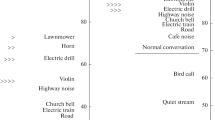Abstract
The complex relationship among long-term exposure to environmental noise, self-reports of health, and sleep was investigated in a multifactorial design. Forty-seven women and 35 men living beside a street with moderate to heavy traffic took part. They answered questions concerning health complaints, usual sleep patterns, sleep the actual week of testing, their subjective responses to noise, psychosocial relations, anxiety, stressful life events, type A behavior, and attitudinal factors that could explain their responses to noise. No detrimental relations among objective noise levels, health, and sleep could be shown. There were, however, strong correlations between the subjective noise responses of annoyance and sensitivity and health complaints. Only women revealed a relationship between poor sleep quality and sensitivity. The stronger relationship among noise sensitivity, health complaints, and poor sleep quality for women than for men could be explained by the degree of exposure to noise as evidenced by their longer residence and greater time spent at home.
Similar content being viewed by others
References
Babisch, W., Ising, H., Gallacher, J. E. J., and Elwood, P. C. (1988). Traffic noise and cardiovascular risk. The Caerphilly study, first phase. Outdoor noise levels and risk factors.Arch. Environ. Health 43: 407–414.
Bortner, R. W. (1969). A short rating scale as a potential measure of pattern A behavior.J. Chron. Dis. 22: 87–91.
Bradley, J. S., and Jonah, B. A. (1979). The effects of site selected variables on human responses to traffic noise. I. Type of housing by traffic noise level.J. Sound Vibrat. 66: 589–604.
Cohen, S., Evans, G. W., Stokols, D., and Krantz, D. S. (1986).Behavior, Health, and Environmental Stress, Plenum Press, New York.
Griffiths, I. D., and Delauzun, F. R. (1977). Individual differences in sensitivity to traffic noise: An empirical study.J. Sound Vibrat. 55: 93–107.
Griffiths, I. D., Langdon, F. J., and Swan, M. A. (1980). Subjective effects of traffic noise exposure: Reliability and seasonal effects.J. Sound Vibrat. 71: 227–240.
Holmes, T. H., and Rahe, R. H. (1967). The Social Readjustment Rating Scale.J. Psychosom. Res. 11: 213–218.
Jonah, B. A. Bradley, J. S., and Dawson, N. E. (1981). Predicting individual subjective responses to traffic noise.J. Appl. Psychol. 66: 490–501.
Knipschild, P., and Sallé, H. (1979). Road traffic noise and cardiovascular disease.Int. Arch. Occupat. Environ. Health 44: 55–59.
Langdon, F. J., and Griffiths, I. D. (1982). Subjective effects of traffic noise exposure. II. Comparisons of noise indices, response scales, and the effects of changes in noise levels.J. Sound Vibrat. 83: 171–180.
Langdon, J. (1987). Some residual problems in noise nuisance: A brief review. In Koelega, H. S. (ed.),Environmental Annoyance: Characterization, Measurement, and Control, Elsevier, Amsterdam.
Neus, H., Ruddel, H., and Schulte, W. (1983). Traffic noise and hypertension. An epidemiological study of the role of subjective reactions.Int. Arch. Environ. Health 51: 223–229.
Nivison, M. E., and Nordby, H. (1992). The effects of interstimulus interval length on short and long-term habituation of psychophysiological responses and on self-reported arousal (submitted for publication).
Nivison, M. E., Nordby, H., and Gjestland, T. (1987). The effects of length of interstimulus interval on psychophysiological responses and on self-reported arousal.J. Sound Vibrat. 116: 169–180.
Nivison, M. E., Hjorthol, R., and Kolbenstvedt, M. (1992). The relationship between traffic noise, subjective responses to noise, self-reported health complaints, and sleep quality in a large sample (submitted for publication).
Raw, G. J., and Griffiths, I. D. (1988). Individual differences in response to road traffic noise.J. Sound Vibrat. 121:; 463–471.
Spielberger, C. D., Gorsuch, R. L., and Lushene, R. E. (1970).STAI Manual for the State-Trait Anxiety Inventory, Consulting Psychologists' Press, Palo Alto, CA.
SPSS (1983).SPSS-X User's Guide, SPSS.
Stansfeld, S. A., Clark, C. R., Jenkins, L. M., and Tarnopolsky, A. (1985). Sensitivity to noise in a community sample. I. Measurement of psychiatric disorder and personality.Psychol. Med. 15: 243–254.
Statens Vegvesen og Miljøverndepartement (1979).Nordisk Beregningsmetode for Vegtrafikkstøy, Håndbok 064, Statens Vegvesen, Oslo.
Tarnopolsky, A., Barker, S. M., Wiggins, R. D., and McLean, E. K. (1978). The effect of aircraft noise on the mental health of a community sample: A pilot study.Psychol. Med. 8: 219–233.
Tarnopolsky, A., Watkins, G., and Hand, D. J. (1980). Aircraft noise and mental health. I. Prevalence of individual symptoms.Psychol. Med. 10: 683–698.
Ursin, H. (1987). Personality, activation, and psychosomatic disease. In Magnusson, D. and Øhman, D. (eds.),Psychopathology: An International Perspective, Academic Press, New York.
Ursin, H., and Murison, R. (eds.) (1983).Biological and Psychological Basis of Psychosomatic Disease, Pergamon, Oxford.
Ursin, H., Endresen, I. M., and Ursin, G. (1988). Psychological factors and self-reports of muscle pain.Eur. J. Appl. Physiol. 57: 282–290.
von Eiff, A. W., Friedrich, G., and Neus, H. (1982). Traffic noise, a factor in the pathogenesis of essential hypertension.Contrib. Nephrol. 30: 82–86.
Watkins, G., Tarnopolsky, A., and Jenkins, L. (1981). Aircraft noise and mental health. II. Use of medicines and health care services.Psychol. Med. 11: 155–168.
Weinstein, N. D. (1980). Individual differences in critical tendencies and noise annoyance.J. Sound Vibrat. 68: 241–248.
Weinstein, N. D. (1982). Community noise problems: Evidence against adaptation to noise.J. Environ. Psychol. 2: 87–97.
Author information
Authors and Affiliations
Additional information
This study was supported by grants from the Norwegian National Pollution Agency, the Nordic Noise Group, and the Norwegian Research Council for Science and the Humanities.
Rights and permissions
About this article
Cite this article
Nivison, M.E., Endresen, I.M. An analysis of relationships among environmental noise, annoyance and sensitivity to noise, and the consequences for health and sleep. J Behav Med 16, 257–276 (1993). https://doi.org/10.1007/BF00844759
Accepted:
Issue Date:
DOI: https://doi.org/10.1007/BF00844759




